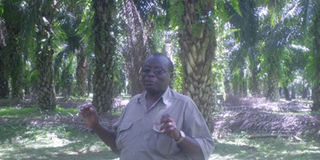Prime
Palm trees: Taking root in Uganda

A researcher at a palm tree plantation: Over the years, better yielding varieties have been obtained from other parts of the world and adapted to Ugandan conditions. Photo by Lominda Afedraru.
What you need to know:
Palm trees have been grown in Uganda over several decades but with low yields. Efforts by researchers have enabled the improved varieties to overcome this setback.
Growing palm trees as a commercial crop has been capitalised on by large private companies although a number of smallholder farmers are starting to venture into it, mostly as outgrowers.
Traditionally, Ugandan farmers grew a local variety of palm tree, which contained large seeds that yielded few fruits leading to less oil output and thus less income.
Variety improvement
The National Crop Resources Research Institute (NaCRRI) branch, at Kituuza, in Mukono District, later introduced high breed varieties which have origins in West Africa.
But, according to the head of the research team, Dr Patrick Wetala, farmers from Bundibugyo District had been growing wild varieties which originated from present-day D R Congo in the 1930s. This was specifically for extracting crude palm oil for home consumption.
In 1972, improved palm varieties were obtained in the form of seeds from Cote d’Ivoire, which were planted in various locations including Kalangala, Bundibugyo, Kituuza, Nakabago and Jinja, for further variety improvement.
Advice
“When a breeder plants the seeds, he or she incorporates them in moisture and leaves them to grow for three months before transfer to a nursery where they are left for another 18 months before taking them to the field,” Dr Wetala explains.
“We advise farmers to make planting spacing of nine metres by nine metres with a total of 143 trees per hectare. This will enable the farmer to harvest from 14 to 17 tonnes per hectare per year yielding about four tonnes of oil.”
Oil production
The team later observed that the plant adapted well to the Ugandan soil and farmers started engaging in growing the plant.
Later, in 1991, high breed varieties were obtained from Costa Rica and grown in Kalangala, Masindi, Bundibugyo, Hoima, Mayuge and Masaka for field tests to investigate the agronomy practices such as effects on the soil fertility, pruning, pest and disease infection.
These varieties, according to Dr Wetala, are the dwarf types and they tend to produce more fruits compared to the tall palm trees.
In three years’ time, they are capable of producing eight bunches per tree during the first fruiting; after 12 years, their production increases to 40 bunches per tree. Most farmers began planting them in 2001, and last year, they began extracting the oil from the fruits.
At Kituuza, there is a plantation of the dwarf variety and Dr Wetala said from this variety both the private companies and smallholder farmers are experiencing a 25 per cent oil production, which is used for making cooking oil, soap and cosmetics, among others.
The crude oil is sold at about Shs2,000 per litre but in West Africa, the farmers even process wine out of the fruit. In Uganda, some processors are interested in using the tree trunks in making paper.
Apart from the opportunities, farmers are faced with challenge of pests and diseases. Dr Georgina Hakiza, a researcher at the institute, says farmers complain of insects like mill buds, and vertebrate pests like rodents, monkeys, dogs, weaver birds and eagles eating the fruits from the tree.
Dealing with challenges
There are diseases caused by Rhinoceros beetles, which produces larva on the most top part of the tree causing defects in its growth. Others are leaf spotsm, which attack the plants when they are still young causing them to collapse.
There is also fungal infection such as ganoderma root rot and mushrooms, which grow at the roots of the plants causing them to rot.
For these challenges, farmers are advised to cut down the affected plants and use the appropriate agronomy practices.




